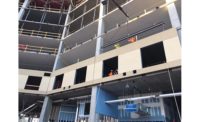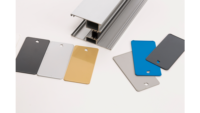Estes Design and Manufacturing, a full-service sheet metal fabricator, uses advanced automation and a collaborative approach to produce exterior aluminum architectural panels that are easier and faster to install. A recent completed project was the 30,000-square-foot Fishers, Indiana, Fire Station.
1,003 pre-painted, .050 aluminum architectural and soffit panels were fabricated using a fully automated fabrication cell – with zero remakes.
Interlocking features of the architectural panels were designed in partnership with The Hitzfield Group of Noblesville, Indiana, which designs and installs building envelopes and structural façade components nationally. Stephen Hendrickson, director of design and engineering with the Hitzfield Group, attributes this project’s success to the advanced technology and automation used in the process.
“Estes helped us work through specific design items collaboratively with their engineering department, and we took full advantage of the technology they utilize to help design, produce and simulate the fabrication process,” Hendrickson said. “By the time our material was ready to be fabricated in the shop, they were already very familiar with our parts and confident they could fabricate them very efficiently.”
Estes’ fully automated fabrication cell, Max Velocity, starts with the raw material being loaded into the Salvagnini MV Warehouse. Next, traceability information for each bundle of raw material is recorded and stored in the cell’s software, following the part throughout the fabrication process.
Estes’ automated warehouse runs through the cell’s center and automatically delivers materials and parts to and from the four pieces of equipment in the cell: two Salvagnini CNC S4 shearing/punching machines, a Salvagnini CNC L5 fiber laser system and a Salvagnini CNC panel bender.
An additional freestanding Salvagnini CNC P2 Panel Bender is a fully automated machine that bends sheet metal blanks into their final shape. Its advanced capabilities allow it to form complex parts in a single setup.
Unlike traditional press brakes that require different tools for different bend configurations, tooling in this panel bender adjusts automatically from bend to bend and part to part. Forming and rotating the part is also fully automated.
In addition, the Salvagnini S4 can place a removable label or a stamped part identifier on each part, quickly allowing the part to be identified throughout the manufacturing process and on the construction site.
The advanced automation in this project not only reduced the set-up time, production time and handling of these panels, but it also produced high-quality, tight-tolerance parts with no remakes.





Report Abusive Comment